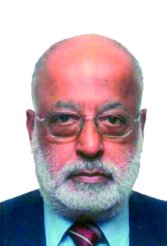By Nicholas Ionides in Mumbai and New Delhi
Indian civil aviation minister Praful Patel has a simple reply to the statement that the country’s air transport growth of the past few years has been phenomenal. “Things were long overdue,” he says, casually shrugging his shoulders. “I guess we just needed to have the will and the vision to push things through.”
That may be true, but few expected the market-changing initiatives that have been put in place since Patel took over in May 2004 when a new government came to power. Since then India’s domestic and international air transport markets have boomed: in 2004 domestic passenger numbers jumped nearly 20%. That was followed by more than 25% growth last year and this year’s forecast is for more than 40% growth.
“The government is doing a hell of a lot,” says Saroj Datta, executive director of Jet Airways. He adds that while much more needs to be done, particularly on the infrastructure side, “things are moving in the right direction”.
For years India’s air transport market was stifled by restrictive policies and old-fashioned attitudes towards flying. But now consumerism is in the air and the Indian middle class – already by far the largest in the world at an estimated several hundred million people – is growing fast. This is putting intense pressure on the bureaucracy to bring about regulatory change in all sectors of the economy, which is expected to grow by more than 8% in terms of gross domestic product (GDP) this year. Given that civil aviation growth in India has traditionally lagged behind GDP, the potential is enormous.
“We have the youngest population in the world. Fifty per cent of India is under 25 and 400 million Indians are under 18. These youngsters are getting better educated for the first time and are getting better jobs,” says Vijay Mallya, chairman and chief executive of Kingfisher Airlines, which was launched in May last year.
 |
|---|
“We have no roads and road transport connectivity to speak of. So what is the only option? You either fly or you go by train. We have the largest railway network in the world, but the railway is positioned deliberately by the government for the masses, whether it is the timings or the speed of the trains, their schedules, or where they stop.
“So what option does the growing middle class have in India? The youngsters who are getting better jobs, earning more money, who want to have better lifestyles, what option do they have to travel? Only to fly. Therefore the civil aviation opportunity itself in India is unique.” Kingfisher is one of four new privately owned carriers that launched services in 2005, the others being Go Air, Paramount Airways and SpiceJet. Several more are planned.
The launches have come on the back of the success of charter operator Deccan Aviation’s move to establish Air Deccan as the country’s first no-frills, low-fare airline. It launched services in August 2003 and since then has recorded phenomenal growth, in turn helping to change attitudes towards civil aviation. Unlike Kingfisher, Air Deccan believes the real growth in Indian air transport will come from converting rail and bus passengers to airline travellers.
“We started with one aircraft and now have 35, and will be adding something like 100 in the next 100 months. Last year we carried 3 million passengers and this year it will be 7.5 million,” says Air Deccan managing director Capt G R Gopinath.
“Obviously these passengers are not Jet Airways and Indian Airlines passengers because both of them are also growing. So this is a new market we have created, largely from the trains and buses.”
He adds: “Every day 18 million people travel on the trains and 12 million on the buses. That’s 30 million combined and I want to take away 10% of that, which is 3 million passengers a day. That means, obviously, there is huge potential.”
|
|---|
| "We should be able to compete on a more equitable ground" V Thulasidas, Chairman, Air India |
First-time travellers
Once considered a luxury only for the elite, flying is now becoming more commonplace in India, where until recently more people travelled domestically by train each day than travelled by air in an entire year. Gopinath claims 30-40% of the passengers on Air Deccan are first-time travellers.
The government has, without question, helped the industry by lowering civil aviation-related taxes, improving airport infrastructure, easing regulatory restrictions and generally providing public support for the new players. Patel says the government’s thinking was that there were two ways to bring about development – either by holding back growth until the infrastructure was ready or by opening up quickly and allowing the growth to promote infrastructure improvements. It chose the latter, and the gamble has paid off.
“We could have taken the route of China, where they build new infrastructure and the demand follows, but in India we chose to boost the demand and the pressure on infrastructure followed,” Patel said in an interview at his New Delhi residence during a break from a session of parliament.
“If we had waited for the infrastructure to come it would have taken a few more years and probably delayed the growth, which was long overdue.” Patel says there are no regrets about going this way, and with traffic growth so strong and so many first-time flyers experiencing the convenience of air travel at more affordable prices, the decision is helping to spur on even more rapid change.
He has been able to get major initiatives passed that many thought unlikely: finally allowing privately owned Air Sahara and Jet Airways to launch international services after years of being barred; opening up dozens of air services agreements to allow more foreign airline flights; approving badly delayed fleet modernisations and expansions at state-owned Air-India and Indian Airlines; and pushing through the privatisation of the flagship Mumbai and New Delhi airports in the face of severe union opposition.
|
|---|
| "Last year we carried 3 million passengers - this year it will be 7.5 million" G R Gopinath, Managing Director, Air Deccan |
Now Patel is working to push through his most ambitious move to date – a merger of Air-India and Indian Airlines. And despite great scepticism from critics who say the workforces of the two carriers will never allow it to happen, he insists the two will be combined by the end of this fiscal year that ends next March.
“Air-India and Indian Airlines will be merged in fiscal year 2006-7. It will be happening – 100% sure,” he says. “It has to. It is being driven by a strong desire in government to make things happen. We have got to make things happen.” He adds: “In two years we have demonstrated we can do things.”
Mumbai-based Air-India operates mainly international services while Delhi-based Indian Airlines operates domestic services as well as short- and medium-haul international services.
Patel says preparation work for the merger is well under way, although full details such as the surviving name of the enlarged entity or the location of its main base have not been determined. “Both have to leverage on the strengths of each other. One is a strong domestic carrier, one is a strong international carrier, so they can leverage on the fleet, on the engineering, on their marketing to be even stronger.”
For their part, Air-India and Indian Airlines say publicly that they are in favour of a merger, believing it will help them compete more effectively in this fast-changing market.
Indian merger
Air-India chairman V Thulasidas says a merger will create a true “network” airline operation and help the enlarged carrier compete better against rival privately owned Indian airlines as well as foreign operators, which have been aggressively boosting services to the country. “We want to combine the two large airlines of India into a large Asian airline group, and we should be able to then compete on a more equitable ground,” says Thulasidas.
“We have been held back so far despite the fact that in the past three years we have been able to expand the size of the fleet and the operations. Something of the order of 125-150 aircraft, that is what we can have with the two airlines together, and that will make us one of the largest and strongest airlines in Asia.”
Patel also sees mergers among private airlines as inevitable as the rapid market changes reveal which will be the survivors. “It is an evolutionary process because aviation both in India and internationally has to be driven by some kind of scale and basically critical mass,” says Patel.
|
|---|
| "There are limitations in this environment" Saroj datta, Executive Director, Jet Airways |
Many industry analysts have been predicting that consolidation will take place and early this year Jet Airways agreed to buy rival Air Sahara, although there were recent indications the acquisition may not go ahead. Like Patel, Datta of Jet Airways believes more consolidation will come to the market.
“Notwithstanding the huge growth in the market that is taking place – and it is truly unbelievable traffic growth – I personally believe that for so many players with so many similar products and similar business philosophies, to be able to live this out and establish themselves is going to be difficult,” he says.
“There are limitations in this environment, particularly on infrastructure, irrespective of what is being done. That is ultimately going to block a lot of us from either growing or leaving a permanent imprint in the market.”
India’s airlines say the market is already at the stage where traffic growth is being stifled by a lack of airport capacity, primarily at the main Delhi and Mumbai hubs. Patel says the government is well aware of this and it is one of the reasons Delhi and Mumbai airports have been privatised – so they can be developed by their new long-term lease holders and ultimately become regional and international hubs as well. At the same time he is working to push air transport out of the biggest cities into other parts of the country.
“It is very healthy growth and I feel that on average in the next 10-year horizon Indian aviation will grow 25% annually,” says Patel, adding that the country’s fleet of commercial aircraft may also increase to 2,000 by 2015 from the current 210.
“But it can grow more, it can grow faster, and for that we need the infrastructure in place. That is exactly what we are now working on. Our entire efforts are directed at building up the infrastructure. Not only for Mumbai and Delhi. We want to also make it happen across the country.”
Patel says pushing aviation development beyond just Delhi and Mumbai will be a key focus of a new civil aviation policy for the country. It is being finalised now and will provide the framework for further development of the airline sector over the next decade. “There is no ambiguity in the direction we are moving,” he says. “We are incorporating [in the new policy document] what is good for aviation for the next five to 10 years.”
New aviation policy
Patel says the civil aviation policy will outline the government’s plans for development of airports at the six major cities of Bangalore, Delhi, Chennai, Hyderabad, Kolkata and Mumbai, as well as 35 “non-metro” cities. “India is a large country both in terms of geography and population, but we have had Mumbai- and Delhi-centric aviation growth in the past five decades. Now we intend to redistribute the overall pattern of aviation in the country,” he says.
The new policy will also outline how the government intends to promote growth in badly undeveloped areas such as cargo. “Cargo is one very major area of growth for India and we are looking at making cargo a very major component of our aviation business in India,” says Patel.
“We have too few [freighter] planes flying in India at the moment. In cargo we have just about five aircraft [with privately owned Blue Dart Aviation] and we think we can scale that up to at least 150 aircraft in the next five to 10 years.”
His message appears to be reaching the right audience, as already a courier company is preparing to launch a new freighter operation and passenger carriers such as Go Air, Indian Airlines, Jet Airways and Kingfisher are talking about adding freighters.
This is one of many signs that the government is finally having a positive influence over the airline sector, after years of bureaucrats holding back growth. Patel says there is simply “no question of turning back” now.
“The only path is the way forward and we have to keep the pace and momentum going,” he says. “And that will happen. No question.” ■
From possible first-class A380 cabin layouts to what US airports think about their airline cousins, visit our blog at www.airlinebusiness.com
Source: Airline Business



















